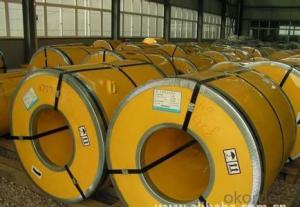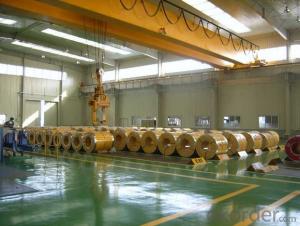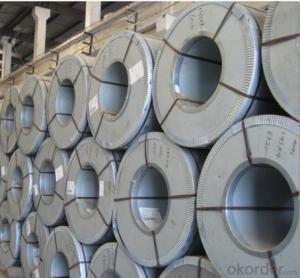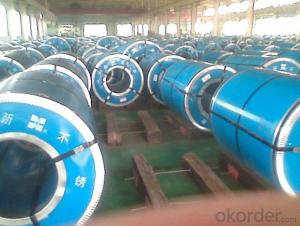Stainless Steel Coil Cold Rolled 201 Full Hard Surface No.2E with High Quality
- Loading Port:
- China main port
- Payment Terms:
- TT or LC
- Min Order Qty:
- 25 m.t.
- Supply Capability:
- 20000 m.t./month
OKorder Service Pledge
OKorder Financial Service
You Might Also Like
1. Structure of Stainless Steel Coil Cold Rolled 201 Descriptions
Stainless Steel 201 is a new kind of Austenite stainless steel by used Mn, N replace Ni.
The steel has good corrosion resistance and hot / cold processing performance, instead of 304 stainless steel products for used in the not high of corrosive environment, such as indoor, inland city outdoor etc.
2. Main Features of the Stainless Steel Coil Cold Rolled 201
Thickness: 0.2mm to 1.5mm
Width: 10mm to 1240mm
Type: 200 Series
Length: As customer's requested
Standard: JIS, SUS, AISI, ASTM
Grade: 201-J1, 201-J4, AISI201, AISI202…
Finish: BA, 2B, 8K, NO.3, NO.4, HL…
Hardness: Low Hard(190 HV Max); Half Hard(240-280HV); Full Hard(42-60 HRC)
Delivery Time: 15 to 20 day after the receive the deposit or 100%LC
Packaging: By wooden pallet, wooden case or according to customer's request
3. Stainless Steel Coil Cold Rolled 201 Images
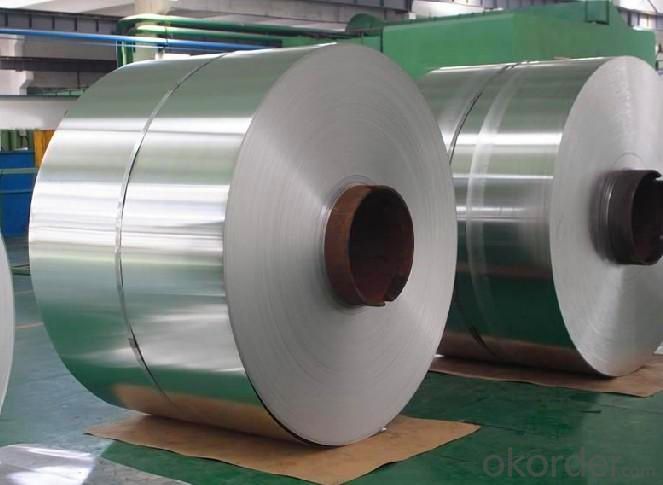
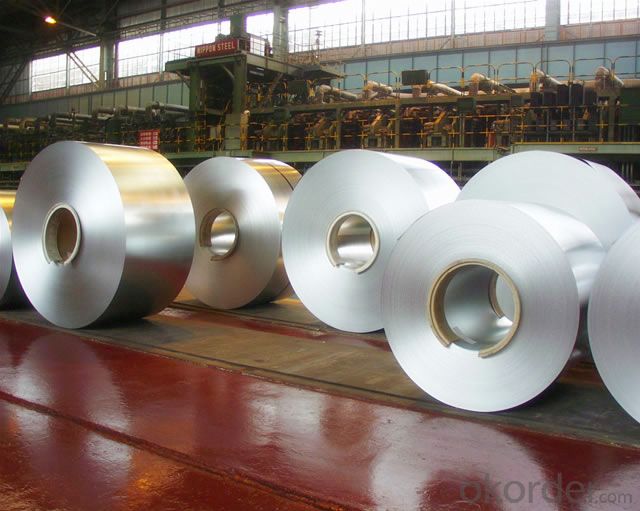
4. Stainless Steel Coil Cold Rolled 201 Specifications
Mechanical Property Contrast | YS (Mpa) | TS (Mpa) | EL(%) | HV | REMARK |
Stainless Steel 201 | 426 | 880 | 52 | 224 | 1.0t |
Stainless Steel 304 | 285 | 710 | 58 | 165 | 1.0t |
Stainless Steel 200 Series Chemicals Contrast (wt. %) | ||||||||
Chemicals | C | Si | Mn | Cr | Ni | N | Other | |
205 | 0.12-0.25 | ≤0.75 | 14.0-15.0 | 16.5-18.0 | 1.0-1.75 | 0.32-0.4 | ||
JIS, | 201 | ≤0.15 | ≤1.0 | 5.5-7.5 | 16.0-18.0 | 3.5-5.5 | ≤0.25 | - |
201L | ≤0.03 | ≤0.75 | 5.5-7.5 | 16.0-18.0 | 3.5-5.5 | ≤0.25 | - | |
202 | ≤0.15 | ≤1.0 | 7.5-10.0 | 17.0-19.0 | 4.0-6.0 | ≤0.25 | - | |
201LN | ≤0.03 | ≤0.75 | 6.4-7.5 | 16.0-17.5 | 4.0-5.5 | 0.1-0.25 | Cu≤1.0 | |
India | 201-J1 | ≤0.08 | ≤0.75 | 7.0-8.0 | 15.0-17.0 | 4.0-5.0 | ≤0.1 | Cu≤1.5 |
201-J3 | ≤0.08 | ≤0.75 | 9.0-10.5 | 14.0-16.0 | 2.0-3.0 | ≤0.15 | Cu≤2.0 | |
201-J4 | ≤0.10 | ≤0.75 | 8.5-10.0 | 15.0-16.0 | ≤1.2 | ≤0.2 | Cu≤2.0 | |
America | 204 | ≤0.03 | ≤1.0 | 7.0-9.0 | 15.0-17.0 | 1.5-3.0 | 0.15-0.3 | (Cu) |
H400 | ≤0.10 | ≤1.0 | 6.0-9.0 | 17.0-19.5 | ≤3.5 | ≤0.3 | - | |
Japan | YUS130S | 0.09 | 0.5 | 11.0 | 18.0 | 6.5 | 0.35 | - |
NTK S-4 | 0.17 | 0.43 | 14.7 | 17.7 | 1.3 | 0.35 | - | |
NM15M | 0.08 | 0.8 | 14.5 | 17.0 | 4.3 | 0.33 | - | |
Europe America | 219 | ≤0.04 | ≤0.75 | 8.0-10.0 | 19.0-21.5 | 5.5-7.5 | 0.15-0.4 | - |
Cromanite | ≤0.08 | ≤1.0 | 9.5-11.0 | 18.0-20.0 | ≤1.0 | 0.4-0.6 | - | |
201 Surface | Characteristic and Application of Stainless Steel Coil Cold Rolled 201 |
2B | The surface brightness and flatness of 2B is better than 2D then through a special surface treatment to improve its mechanical properties, 2B could nearly Satisfy comprehensive uses |
No.4 | Polished with abrasive belt of grit#150#180, have better brightness with discontinuous coarse stria, but thinner than NO.3, are used as bathtub buildings inner and electrical appliances kitchen utensils and food processing. |
BA | Cold rolled, bright annealed and skin-passed, the product have excellent brightness like mirror kitchen apparatus, etc. |
8K | The product have excellent brightness and prefer bright can be the mirror. |
5. FAQ of Stainless Steel Coil Cold Rolled 201
Q: Are you factory or trader?
A: We certainly are stainless steel manufacturer and have processing plant.
Q: Can you provide mill test certificate?
A: Yes! Mill test certificate for both hot rolled raw material coils and cold rolled coils are available.
Q: How to get a sample?
A: Free samples are available for your checking and testing. And to get free samples, please send us your detailed receiving address (including post code) and your DHL/FEDEX/UPS account for collecting samples, courier cost will be paid in your side.
- Q:What are the common uses of stainless steel strips in the pharmaceutical packaging industry?
- Stainless steel strips have several common uses in the pharmaceutical packaging industry. One of the primary uses is in the production of packaging containers and components. Stainless steel strips are used to manufacture various types of containers such as vials, ampoules, and syringes. These containers need to be made from a material that is corrosion-resistant, durable, and can maintain the sterility of the pharmaceutical products. Stainless steel, with its high resistance to corrosion and ability to withstand high temperatures, makes it an ideal choice for ensuring the safety and integrity of the packaged drugs. In addition to containers, stainless steel strips are also utilized in the production of packaging components such as lids, caps, and closures. These components play a crucial role in maintaining the quality and freshness of pharmaceutical products. Stainless steel's resistance to rust and its ability to provide an airtight seal make it suitable for ensuring the integrity of the packaged medications. Furthermore, stainless steel strips are utilized in the construction of pharmaceutical machinery and equipment. Pharmaceutical manufacturing processes often involve the use of heavy machinery that requires durable and corrosion-resistant materials. Stainless steel strips are commonly used in the fabrication of machine parts, conveyor systems, and packaging equipment to ensure their longevity and reliability. Another common use of stainless steel strips in the pharmaceutical packaging industry is for labeling and identification purposes. Stainless steel strips can be engraved or etched with important information such as batch numbers, expiration dates, and drug identification codes. This ensures that the pharmaceutical products can be accurately tracked, traced, and identified throughout the packaging and distribution process. Overall, stainless steel strips offer numerous benefits in the pharmaceutical packaging industry. Their corrosion resistance, durability, and ability to maintain sterility make them an essential material for manufacturing containers, components, machinery, and labeling in the pharmaceutical packaging sector.
- Q:Can stainless steel strips be used for electrical connectors?
- Yes, stainless steel strips can be used for electrical connectors. Stainless steel is a highly conductive material that offers excellent corrosion resistance and durability, making it a suitable choice for electrical connectors.
- Q:How can stainless steel strips be welded together?
- Stainless steel strips can be welded together using various welding techniques such as TIG (Tungsten Inert Gas) welding, MIG (Metal Inert Gas) welding, or even spot welding. Each of these methods has its own advantages and considerations. TIG welding is commonly used for stainless steel due to its ability to produce high-quality and precise welds. It involves using a non-consumable tungsten electrode to create an electric arc between the electrode and the base metal. A filler metal is then fed into the weld puddle to join the stainless steel strips together. TIG welding offers excellent control over the heat input and provides a clean and aesthetically pleasing weld. MIG welding, on the other hand, is a more common method for joining stainless steel strips in industrial applications. It involves using a consumable electrode wire that is continuously fed through a welding gun. The wire serves as both the filler material and the electrode. MIG welding is relatively faster than TIG welding and is suitable for thicker stainless steel strips. However, it may produce a less visually appealing weld compared to TIG welding. Spot welding is another option for joining stainless steel strips, especially if they are thin. This method involves applying an electric current to create resistance heat between the two strips at specific spots. The heat generated melts the metal, and pressure is applied to fuse the strips together. Spot welding is a quick and efficient process, commonly used in mass production settings. Before welding stainless steel strips, it is essential to clean the surfaces to remove any contaminants and oxide layers that can affect the quality of the weld. Additionally, proper shielding gases, such as argon or helium, should be used to protect the weld from oxidation and ensure the weld's integrity. It is crucial to select the appropriate welding technique based on the thickness, desired weld quality, and specific requirements of the stainless steel strips. Consulting with a professional welder or referring to welding guidelines provided by the manufacturer is recommended to ensure a successful welding process.
- Q:Can stainless steel strips be used in pharmaceutical storage containers?
- Pharmaceutical storage containers can indeed utilize stainless steel strips. The pharmaceutical industry often relies on stainless steel due to its exceptional corrosion resistance and durability. It is a frequently employed material that can withstand harsh cleaning agents and disinfectants, making it highly suitable for the storage of pharmaceutical products. The use of stainless steel strips in the construction of pharmaceutical storage containers guarantees the preservation and safety of the stored drugs. Furthermore, stainless steel is non-reactive and does not release any harmful substances into the medications, ensuring their purity and efficacy. In summary, stainless steel strips are a dependable and appropriate choice for pharmaceutical storage containers.
- Q:Can stainless steel strips be used in architectural staircase systems?
- Yes, stainless steel strips can be used in architectural staircase systems. Stainless steel is a durable and corrosion-resistant material, making it suitable for high-traffic areas such as staircases. Additionally, stainless steel strips can be fabricated into various designs and finishes, allowing for a sleek and modern aesthetic in architectural staircases.
- Q:What industries use stainless steel strips?
- Stainless steel strips are widely used in various industries due to their excellent properties and versatility. Some of the industries that extensively utilize stainless steel strips include: 1. Automotive Industry: Stainless steel strips are used in the manufacturing of automotive components, such as exhaust systems, trim, and decorative parts. The corrosion resistance, strength, and durability of stainless steel make it ideal for these applications. 2. Construction Industry: Stainless steel strips are commonly used in the construction sector for structural and architectural purposes. They are used in the fabrication of building facades, handrails, cladding, roofing, and reinforcement bars due to their high strength, corrosion resistance, and aesthetic appeal. 3. Aerospace Industry: Stainless steel strips find applications in the aerospace industry where they are used in the production of aircraft components, such as engine parts, exhaust systems, structural elements, and fasteners. Stainless steel's resistance to high temperatures and harsh environmental conditions makes it suitable for this industry. 4. Food and Beverage Industry: Stainless steel strips are extensively used in the food and beverage industry due to their hygienic and corrosion-resistant properties. They are used in the manufacturing of food processing equipment, storage tanks, conveyor systems, and kitchen appliances. 5. Medical and Pharmaceutical Industry: Stainless steel strips are crucial in the medical and pharmaceutical industry due to their excellent biocompatibility, corrosion resistance, and ease of sterilization. They are used in the production of surgical instruments, medical devices, implants, and pharmaceutical equipment. 6. Chemical Industry: Stainless steel strips are widely used in the chemical industry for their resistance to corrosion caused by various chemicals and high temperatures. They find applications in the production of chemical processing equipment, storage tanks, pipes, and valves. 7. Energy Industry: Stainless steel strips are utilized in the energy sector for various applications, including power generation, oil and gas exploration, and renewable energy production. They are used in the manufacturing of turbines, heat exchangers, pipelines, and offshore platforms due to their durability and resistance to corrosion. 8. Electronics Industry: Stainless steel strips are commonly used in the electronics industry for their excellent electrical conductivity and thermal properties. They find applications in electronic components, connectors, and shielding materials. Overall, the versatility, corrosion resistance, strength, and aesthetic appeal of stainless steel strips make them indispensable in numerous industries, ranging from automotive and construction to aerospace, medical, and beyond.
- Q:Can stainless steel strips be used for decorative screens?
- Yes, stainless steel strips can be used for decorative screens. Stainless steel is a versatile material that offers both durability and aesthetic appeal, making it a popular choice for various applications, including decorative screens. The strips can be cut and shaped into different patterns or designs, allowing for creative and customized screen options. Additionally, stainless steel is resistant to corrosion and can withstand outdoor elements, making it suitable for both indoor and outdoor decorative screens. Whether it's for privacy, partitioning, or enhancing the visual appeal of a space, stainless steel strips can be an excellent choice for creating decorative screens.
- Q:What are the advantages of using precision rolled 111 stainless steel strips?
- Precision rolled 111 stainless steel strips offer several advantages. Firstly, they provide uniform and reliable products due to the precision rolling process, which ensures consistent thickness and width. This is especially important in industries like electronics and precision instruments that require precise measurements. Secondly, 111 stainless steel is highly resistant to corrosion, making it ideal for applications exposed to harsh environments, chemicals, or moisture. The corrosion resistance extends the lifespan of the strips, reducing the need for frequent replacements and maintenance. Additionally, these strips have a high strength-to-weight ratio, offering exceptional strength despite being lightweight. This makes them suitable for industries like aerospace, automotive, and construction, where weight reduction is crucial for fuel efficiency and structural integrity. Moreover, precision rolled 111 stainless steel strips are easily shaped and molded, allowing for versatility in various applications. Whether for decorative purposes or functional components, these strips can be bent, stamped, or formed to meet specific design requirements. Lastly, these strips have an aesthetic appeal with a smooth surface finish and lustrous appearance. This makes them highly desirable for decorative applications like architectural accents, jewelry, or kitchenware. The strips can be polished or brushed to achieve different finishes, offering flexibility in design options. In conclusion, the advantages of precision rolled 111 stainless steel strips include consistent thickness and width, excellent corrosion resistance, high strength-to-weight ratio, exceptional formability, and aesthetic appeal. These qualities make them a popular choice in diverse industries, ensuring reliable performance and longevity for their intended applications.
- Q:Can stainless steel strips be customized in size?
- Yes, stainless steel strips can be customized in size. Stainless steel strips are typically available in standard sizes, but they can also be customized to meet specific requirements. Customization in size allows for greater flexibility in various applications, as the strips can be tailored to fit specific dimensions or to meet unique design specifications. This customization can be achieved through processes such as cutting, shearing, or slitting, which enable the stainless steel strips to be resized according to the desired dimensions.
- Q:Can stainless steel strips be used in the production of chemical tanks?
- Yes, stainless steel strips can be used in the production of chemical tanks. Stainless steel is highly resistant to corrosion and chemical reactions, making it a suitable material for storing and transporting various chemicals. The durability and strength of stainless steel strips make them ideal for constructing chemical tanks that require long-term reliability and safety.
1. Manufacturer Overview |
|
|---|---|
| Location | |
| Year Established | |
| Annual Output Value | |
| Main Markets | |
| Company Certifications | |
2. Manufacturer Certificates |
|
|---|---|
| a) Certification Name | |
| Range | |
| Reference | |
| Validity Period | |
3. Manufacturer Capability |
|
|---|---|
| a)Trade Capacity | |
| Nearest Port | |
| Export Percentage | |
| No.of Employees in Trade Department | |
| Language Spoken: | |
| b)Factory Information | |
| Factory Size: | |
| No. of Production Lines | |
| Contract Manufacturing | |
| Product Price Range | |
Send your message to us
Stainless Steel Coil Cold Rolled 201 Full Hard Surface No.2E with High Quality
- Loading Port:
- China main port
- Payment Terms:
- TT or LC
- Min Order Qty:
- 25 m.t.
- Supply Capability:
- 20000 m.t./month
OKorder Service Pledge
OKorder Financial Service
Similar products
New products
Hot products
Hot Searches
Related keywords
